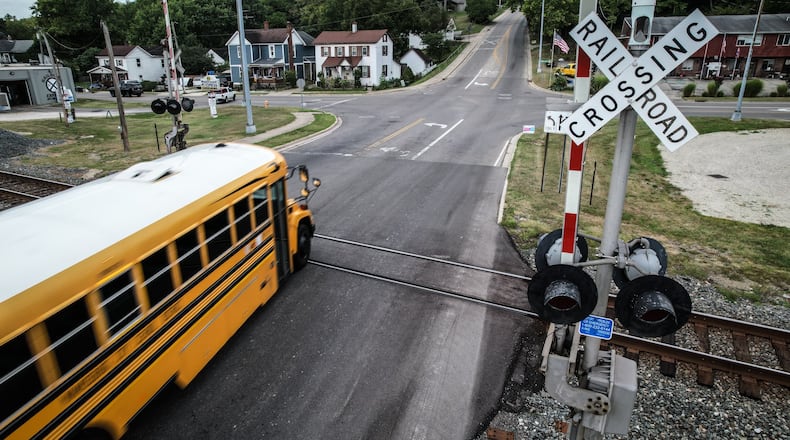Montgomery and Butler counties have both seen fatal automobile crashes involving trains since 2015, according to state data.
One fatal crash was in 2019 on the east side of Miamisburg. City Engineer Bob Stanley said the city commends the state for supporting railroad crossing safety, but that it is not an immediate need for Miamisburg. Stanley said the city has taken advantage of available funds in the past to upgrade safety and permanently close two crossings.
A help for Hamilton
Factors that make a railroad crossing dangerous include how often the rail is used, how many cars travel that particular roadway, and what alternative options drivers have to bypass traffic while a train is rolling by.
This is of particular concern for leaders in the city of Hamilton which, due to several railways dissecting the city through the middle, has only one east-to-west roadway that’s unobstructed by railroad crossings in the entire city — a problem exacerbated by consistent and frequent railway traffic.
Hamilton is already in the project development stage of creating the North Hamilton Crossing, an overpass in a yet-to-be-determined location that would give the city its second unobstructed east-to-west corridor. Allen Messer, assistant director of engineering and North Hamilton Crossing project manager, said the city will look toward this new state program to help alleviate the financial burden.
“It’s excellent seed money. A lot of the grants only cover construction, so it’s kind of filling a gap that exists. It’s very difficult to find funding, usually, for doing your studies and your design, but you need those completed in order to put together a competitive application for the construction, so it’s kind of an area that could use additional funding,” Messer said.
Messer said the new program will allow Hamilton to take on new projects that had been stalled in discussion phases due to the exorbitant costs around planning.
For Hamilton, that means the city will apply for funding to develop plans to consolidate two separate sets of tracks that run north-south through the city before merging together right near downtown. The project would eliminate a handful of crossings altogether.
“That’s one that’s been discussed,” Messer said. “We’re looking to apply for this funding to push that past the discussion phase and hopefully get some legs and some movement (on it).”
Butler County stands out
As a whole, Butler County has struggled with railroad crossings. Since the Public Utilities Commission of Ohio started keeping track of accidents involving trains and vehicles in 2015, the county has seen the third most crashes in the state (29), which resulted in the most fatalities (6) and the most injuries (19). The county is tied for the seventh most railroad crossings in the state with 131.
Three of those crashes occurred at three separate crossings in Hamilton, which is one of several reasons why the city is looking to eliminate as many crossings as it can. Messer said that adding more ways for drivers to travel unobstructed is another way to hopefully limit the amount of crashes, injuries and fatalities at crossing sites.
The other three crashes occurred in Middletown, whose contacted representatives were unable to provide comment before this story’s publication.
Elsewhere in Butler County, an already-planned overpass project on Symmes Road in Fairfield will try to take part in the state’s new program, according to Dan Corey, director of the Butler County Transportation Improvement District. The project recently received federal dollars to go toward planning and development.
“We already got the planning dollars so we’re in a really good spot to now go after construction dollars,” Corey said.
Funds competitive
Dan Tierney, a spokesperson for DeWine, said train crossings can either be a hazard of their own or create additional hazards through traffic, which can cause additional accidents or block emergency services from getting to their destination.
Applications to the program will be reviewed by the Ohio Rail Development Commission, which will pick the applications which it believes have the strongest chance of receiving federal funding and administer funds accordingly. The commission’s spokesperson, Wende Jourdan, told the Dayton Daily News that a crossing’s crash history will be part of the consideration. She also noted that, though the program is designed to help communities reach construction funds, the commission itself could directly fund construction for some projects, if it came down to it.
“The goal is to leverage federal funding but that does not preclude funding projects with significant safety benefits that are not selected by the Federal Railroad Administration for funding,” Jourdan said.
About the Author

